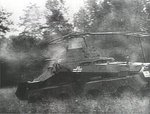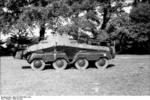SdKfz 231/232/233/263 (8-Rad)
| Country | Germany |
| Primary Role | Armored Car |
Contributor: Alan Chanter
ww2dbaseGerman manufacturer B├╝ssing-NAG had much experience in the construction of large multi-wheeled vehicles which dated back to their experimental ZRW (Zehnradwagen, or ten wheeler) armoured car that they had had submitted for trials in 1929. The knowledge obtained from this and their competitors' ARZ (Achtradwagen or eight-wheeler) proposals for the same trial would provide B├╝ssing's design team with invaluable material for the design of a large eight-wheeled cross-country truck (which never appeared), and finally, when the Heereswaffenamt (the German Department responsible for procurement) decided on the sort of armoured car that would be needed by the army, were sufficiently able to provide a suitable chassis that to be utilised as its basis.
ww2dbaseWhile the six-wheeled SdKfz 231 (6-rad) armoured cars were being developed during the 1930s, B├╝ssing-NAG was also approached to prepare a new armoured car design utilising this eight-wheeled chassis. The specification demanded called for a rear-engined vehicle with front and rear driving positions and with drive and steering on all eight wheels. It was to be fitted with an armoured body with a turret to mount a 20mm KwK 30/38 automatic cannon and a co-axial 7.92mm MG34 machine gun and, since it was to take over the functions of the six-wheeled armoured cars, it was originally given the same Sonderkraftfarhzeug (Special Purpose Vehicle) number, SdKfz 231.
ww2dbaseThe resultant vehicle which many considered to be among one of the most successful German military vehicles of World War II proved to be extremely popular with crews, although it did suffer from the relatively slender chassis (since much of the strength of the vehicle came from the lightly armoured bodywork) and somewhat over complex mechanical layout. On the chassis were mounted two steerable four-wheel bogies with all wheels driven through a series of transfer boxes and differentials from the rear mounted engine. In normal use the front four wheels steered and the rear wheels were locked but, in emergencies, the forward-reverse box was engaged, and the second driver took control to drive off backwards, in which case the former rear bogie was steered and the former front bogie were locked. Originally the SdKfz 231 (8-rad) was powered by a 155bhp 7,913cc B├╝ssing-NAG V-8 petrol engine, but in 1939 the cylinders were enlarged to produce 180bhp engine which provided a better performance.
ww2dbaseThe armoured hull design drew much from the preceding SdKfz 231 (6-rad) armoured cars. It was of very similar shape (although reversed) to that of the six-wheeler and proved to be of a satisfactory ballistic design. Likewise, the turret was of similar concept, although the face was cleaned up and the co-axial machine-gun was transferred to the left of the 20mm cannon. For their size the SdKfz 231 cars were only lightly armoured and armed, the emphasis being on mobility. The armour plate thicknesses were, in fact, no more than comparable with those of the other German light 4 x 4 armoured cars, although, in some cases, an extra spaced plate was added to improve protection in the field.
ww2dbaseUsed to the full in every German campaign, from the invasion of Poland onwards, the SdKfz 231 (8-rad) remained in service throughout the war despite production being terminated in 1942 in favour of the improved SdKfz 234 range of armoured cars.
ww2dbaseVariants
ww2dbaseThree sub-variants of the standard SdKfz 231 (8-rad) armoured car were developed:
ww2dbaseThe SdKfz 232 Schwere Panzersp├Ąhwagen (8-rad) (FU) with additional radio equipment and frame aerial. This was 0.2 tons heavier than the standard armoured car. It had a crew of four and was similarly armed with the 20mm cannon and co-axial machine gun.
ww2dbaseThe turret-less SdKfz 263 Panzerfunkwagen (8-rad) was a long-range command vehicle. This had the height of the hull raised slightly to protect a five-man crew. A static frame aerial was fitted (being replaced during the war years by simpler rod-aerials, as was the SdKfz 232). Provision was made for the mounting of a single machine-gun, although this was not always carried. The SdKfz 263's were generally employed by the signals section of armoured reconnaissance battalions and also with the Panzer Signals Abteilungs.
ww2dbaseLast to appear was another turret-less vehicle, the SdKfz 233 Schwere Panzersp├Ąhwagen 75mm. This entered service in 1941 and was used in the close support role. Armed with a short-barrelled 75mm L/24 howitzer in an open-topped fighting compartment with only a limited traverse (and apparently with no other secondary armament) the SdKfz 233 replaced the towed 75mm howitzers in the armoured reconnaissance battalions' heavy weapons squadrons.
ww2dbaseMakers
ww2dbaseB├╝ssing-Nag, Liepzig-Wahren (Chassis)
Deutsche-Werke AG, Kiel (Body)
F. Schicau, Elbing (Assembly)
ww2dbaseSources:
Ian V Hogg & John Weeks, The Illustrated Encyclopedia of Military Vehicles (Hamlyn 1980)
Bryan Perrett, German Armoured Cars and Reconnaissance Half-Tracks 1939-45 (Osprey New Vanguard, 1999)
B. T. White, Tanks and other AFVs of the Blitzkrieg Era 1939-41 (Blandford Press, 1972)
Bruce Quarrie, Panzers in the Desert (Patrick Stephens, 1978)
Last Major Revision: Sep 2012
SPECIFICATIONS
SdKfz. 232 (8-Rad)
| Machinery | One B├╝ssing-NAG L8V-G 8-cylinder gasoline engine rated at 155hp |
| Suspension | Wheel |
| Armament | 1x20mm KwK 30 L/55 autocannon, 1x7.92mm MG34 machine gun |
| Armor | 8-15mm |
| Crew | 4 |
| Length | 5.90 m |
| Width | 2.20 m |
| Height | 2.90 m |
| Weight | 8.0 t |
| Speed | 85 km/h |
| Range | 300 km |
Photographs
 |  |
Did you enjoy this article or find this article helpful? If so, please consider supporting us on Patreon. Even $1 per month will go a long way! Thank you. Share this article with your friends: Stay updated with WW2DB: |
- » Wreck of USS Edsall Found (14 Nov 2024)
- » Autumn 2024 Fundraiser (7 Nov 2024)
- » Nobel Peace Prize for the Atomic Bomb Survivors Organization (11 Oct 2024)
- » Wreck of USS Stewart/DD-224 Found (2 Oct 2024)
- » See all news
 |
- » 1,150 biographies
- » 337 events
- » 43,917 timeline entries
- » 1,241 ships
- » 350 aircraft models
- » 207 vehicle models
- » 374 weapon models
- » 123 historical documents
- » 260 facilities
- » 470 book reviews
- » 28,541 photos
- » 432 maps
Winston Churchill
Please consider supporting us on Patreon. Even $1 a month will go a long way. Thank you!
Or, please support us by purchasing some WW2DB merchandise at TeeSpring, Thank you!